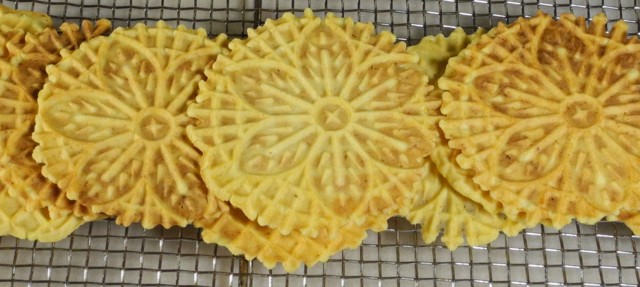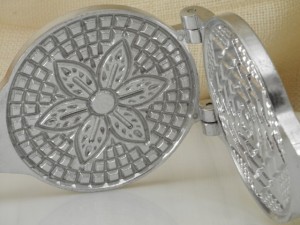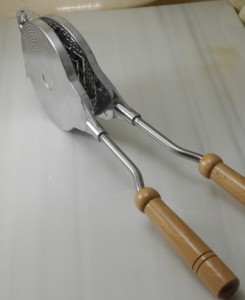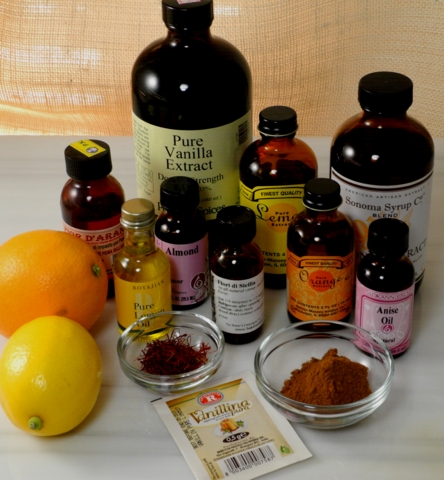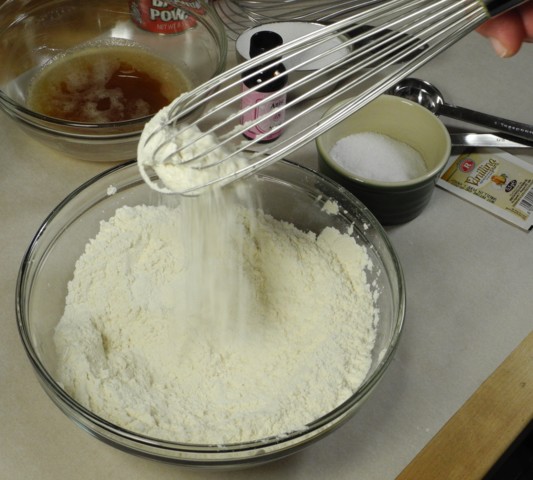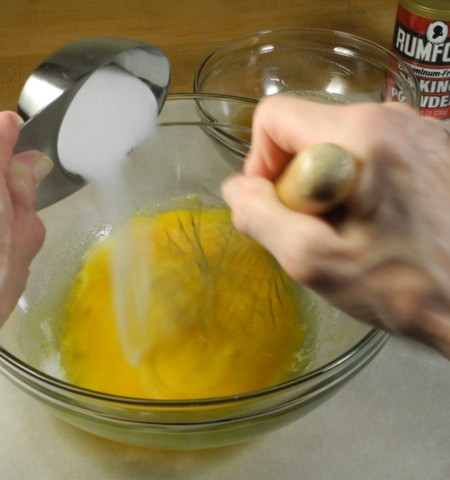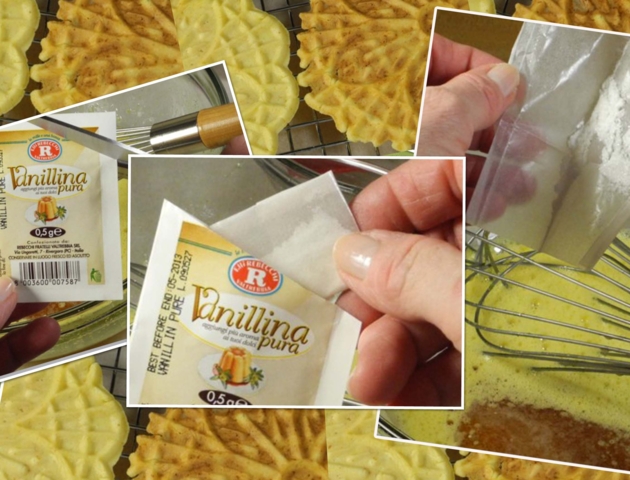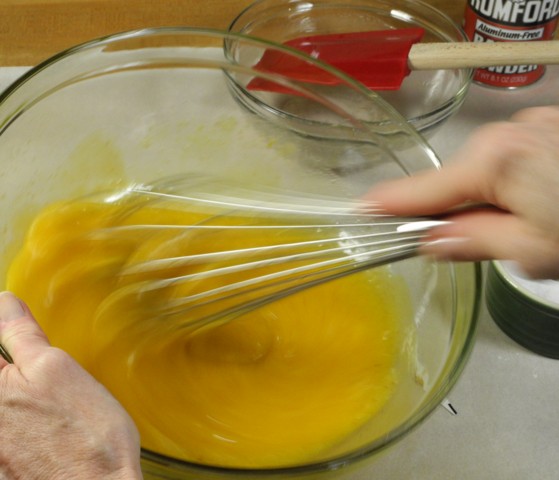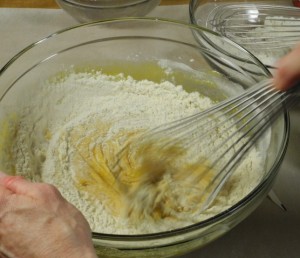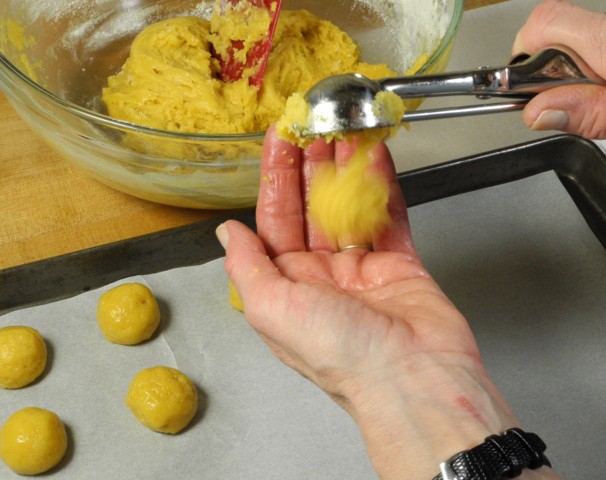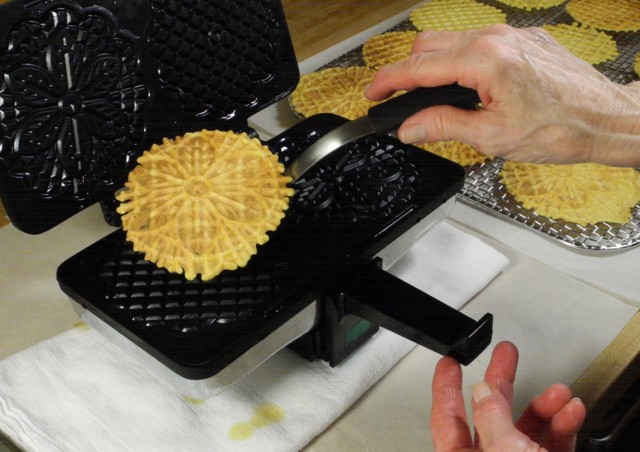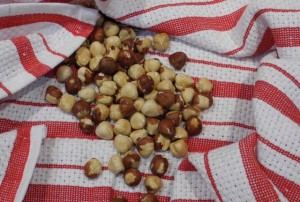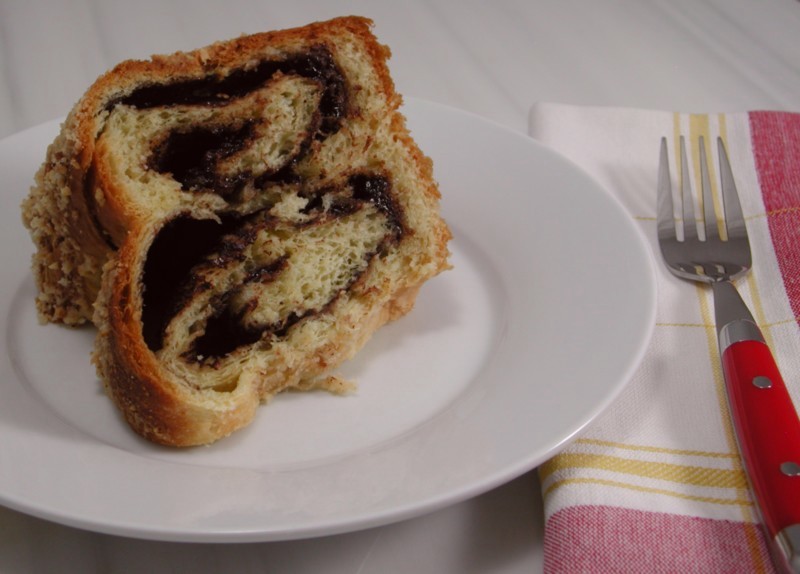
I like Nutella. I really like sweet yeast risen coffee cakes, the kind with a dough like brioche. And the other day I was craving a sweet coffee cake. Can you guess what’s coming? Just in time for Little Christmas, it’s Nutella Coffee Cake, of course. Nutella, that delicious concoction of hazelnuts and cocoa seems to go with just about everything in the bakery department. Developed during World War II by Pietro Ferrero, it was originally supplied in a foil wrapped loaf called pasta gianduja. Over time the formulation was changed to the spread we know today and it became known as supercrema gianduja. And in 1964 the name was changed to Nutella. It has been sold in the United States since 1983, and in recent years it has become extremely popular. With good reason, I’d say. I think of it as the Italian answer to peanut butter. Check out the Nutella USA web site and enter the Nutella Monthly Case Sweepstakes to win a case of Nutella. Oh, one thing more, when you open a jar of Nutella don’t throw away the gold seal. Collect them to use to redeem cool Nutella stuff like tee shirts, mugs and more. Really. I mean how good does life get?
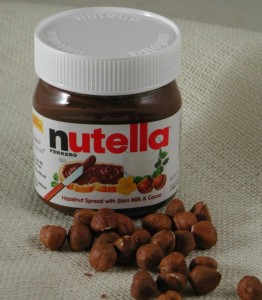
Many cultures have sweetened filled yeast breads; Italians have their nut filled Gubana from Friuli, Eastern Europeans have Babka typically filled with nuts and dried fruit while Jewish bakers fill their Babka with chocolate or cinnamon and crown it with streusel. Now I have Nutella Coffee Cake, a sumptuous brioche-like concoction filled with Nutella, rolled up, twisted, plopped in a pan, topped with streusel and baked to tender yeasty sweet-filled perfection.
I started with a sweet brioche-like yeast dough, rolled it out in 2 batches, just to make it easier to put it in the pan, spread each piece of dough with half a jar of Nutella, rolled them up jelly roll style, gave them a twist and put them in a tube pan. I figured that although I was craving something sweet, maybe, just maybe the Nutella along with the sweet dough would be too much. So I opted for buttermilk, just to give the dough a bit of a tang to counteract all that sweetness. Then I got to thinking I needed maybe just a little something more than the dough and the Nutella, something more on top perhaps. The idea of a streusel sounded darn good to me. I went with it. Once the dough was in the pan, I spread some butter on top and sprinkled it with a streusel of sugar, flour, butter and, in a nod to the Nutella, toasted hazelnuts. This is for those who are serious about their Coffee Cake.
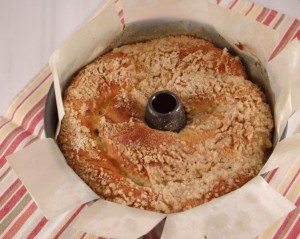
For those of you who do not make yeast breads, fear not. Do not be daunted by the thought of working with yeast. I use SAF Instant Yeast, a baker’s dream. No dissolving, no worrying about the temperature of your liquids and no proofing. Just mix it in with the dry ingredients and you are ready to go. SAF Gold Instant Yeast is particularly good for use in sweet breads. Baked goods with lots of sugar can take forever to rise. Why? The sugar attracts the water and the yeast can not get any. Thirsty yeast will rise slowly. The yeast in SAF Gold needs less water, thus no conflict in your dough, only peace, harmony and a most remarkable rise. You will love it. You may not find it on your grocer’s shelf, however it is available from the King Arthur Baker’s Catalogue, along with just about every other cool item for baking.
I have called for 00 flour because I love the soft, tender dough I get when I use it. If you do not have it, you will still get a wonderful result with all-purpose flour. For more info on 00 flour, see my post on Crostoli.
A word about the hazelnuts – you will need to toast and skin them. Toasting brings out their wonderful flavor and allows you to skin them with some degree of ease. To toast the nuts, place them on a rimmed baking sheet in a 325 degree oven for ten to twelve minutes, stirring the nuts once or twice. Remove them from the oven, place them in a kitchen towel and rub them vigorously to remove as much of the skins as you can. You will never be able to remove all of the skins, and that is alright. Toasting and skinning is an important step because if left on, the skins will impart a bitter flavor to your final product.
I like to use a 2 piece non-stick angel food cake pan for this coffee cake. Even though I direct you to line your pan with parchment paper, the added benefit of a non-stick pan makes it that much easier to remove the coffee cake. If you are not familiar with yeast breads and rolled coffee cakes, this might all seem like a bit of a challenge, but press on. Your efforts will be rewarded and after you have made it once you will wonder what all the fuss was about. A nice thing about this recipe is you can do the second rise in the refrigerator overnight. You can even make the streusel days ahead and keep it in the freezer until you are ready to use it.
When you assemble this coffee cake you may find that the ends of the dough do not meet, especially with the second piece of dough that will lay around the outside of the pan. Do not worry. Do not fuss. Just place the dough pieces in the pan so that the ends of one piece are on the opposite sides of the pan from the ends of the first piece. The dough will rise sumptuously, you will have luscious pockets of Nutella, and your Coffee Cake will have character.
I hope you try this Coffee Cake. It is just as good the day after as it is the day you make it. Do not think of this as a lot of work, but rather several steps. And since all you have to do for the filling is open a jar of Nutella, it is almost easy. (I have to be careful saying a recipe is easy. My sister Toni never believes me.) Try this one. It’s great for breakfast or brunch, and it is just in time for Little Christmas. I bet that like me, you will leave your fork on the table and pick it apart with your hands.

Nutella Coffee Cake
Nutella Coffee Cake
makes one large 10 inch coffee cake
For the dough:
2 3/4 cups 00 flour
1/3 cup sugar
2 1/2 teaspoons instant yeast
1/2 teaspoon kosher salt
1/2 cup buttermilk, at room temperature
2 whole eggs
1 egg yolk
1 teaspoon vanilla extract
4 ounces (1 stick) unsalted butter, very soft, cut into 16 pieces
2 tablespoons unsalted butter
extra butter for bowl and pan
flour for dusting work surface
For the streusel topping:
1/2 cup 00 flour
1/3 cup hazelnuts, toasted and skinned, about 2 ounces
1/4 cup granulated sugar
4 tablespoons unsalted butter, diced and chilled
For the filling:
1 13-ounce jar Nutella
To make the dough: combine flour, sugar, instant yeast and salt in mixer fitted with paddle attachment and mix briefly to combine. With mixer on low, add buttermilk, whole eggs, egg yolk and vanilla. Beat until dough comes together. Remove paddle and switch to the dough hook. Beat medium-low until dough is shiny and elastic, about 10 to 12 minutes.
Add one stick of the softened butter, piece by piece, blending completely after addition. Beat on low for about 5 minutes, until dough is smooth and elastic. Place dough in buttered bowl. Cover with plastic wrap and set aside in a warm, draft-free area. Let rise until doubled, about 2 hours.
When dough has doubled in size, remove plastic. Press dough down. Cover tightly and refrigerate at least 2 hours or overnight.
To make streusel topping: place flour, hazelnuts and sugar in bowl of food processor fitted with steel blade. Pulse briefly to coarsely chop nuts. Add butter and pulse briefly to form a crumbly mixture. Place streusel in freezer until ready to use.
Butter the bottom and sides of a 10″ angel food cake or tube pan, preferably with a removable bottom. Line bottom and sides of pan with parchment paper. Butter parchment paper.
Divide refrigerated dough in half. On a lightly floured surface, roll one half of the dough into a 13 x 8-inch rectangle. Use an offset spatula to gently spread half the Nutella over the rolled out dough to within 1/4 inch of the edges. Trim edges. Beginning at long end, roll up tightly as for jelly roll; pinch seam to seal. Holding one end of the roll in each hand, carefully twist the roll several times to make a spiral. Nestle dough in prepared pan, wrapping dough around central core, leaving ends loose. Repeat with the remaining dough and Nutella; place second roll in prepared pan, arranging it around the outer perimeter along side the first roll with the ends of the second roll on opposite sides of the pan from the ends of the first. The coffee cake will rise a bit unevenly. Don’t worry. I don’t. And by leaving the ends loose you will get some terrific pockets of Nutella in your finished Coffee Cake.
Melt remaining 2 tablespoons butter and brush it over the dough. (If your butter is very soft, you can spread it over the dough.) Sprinkle streusel mixture on top of dough. Cover with plastic wrap and let rise about 2 hours, until doubled in size.
Preheat oven to 350 degrees. Place tube pan on a baking sheet and bake in center of oven about 45 to 50 minutes, until a cake tester inserted in the center of comes out clean. Cool pan on a wire rack for at least 30 minutes before removing coffee cake from the pan and serving.
Note: You can click on any picture to see a slide show!
Filed in Dessert, History, La storia di Crocetti, Recipes | Tagged: 00 flour, Babka, Coffee Cake, crostoli, Friuli, Gubana, hazelnuts, King Arthur Baker's Catalogue, non-stick angel food cake pan, Nutella, Nutella Sweepstakes, Nutella USA, pasta gianduja, Pietro Ferrero, SAF Gold Instant Yeast, SAF Instant Yeast, Supercrema Gianduja, toasting and skinning hazelnuts

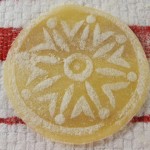 When I first saw one I knew I had to have one. To those of you who know me – no laughing, no eye rolling, please. This time it was for real. And to those of you who do not know me, my friends are laughing because when ever I see any new kitchen item I say I have to have it. But corzetti stamps and the pasta made with them are in a class by themselves. Read more… »
When I first saw one I knew I had to have one. To those of you who know me – no laughing, no eye rolling, please. This time it was for real. And to those of you who do not know me, my friends are laughing because when ever I see any new kitchen item I say I have to have it. But corzetti stamps and the pasta made with them are in a class by themselves. Read more… »